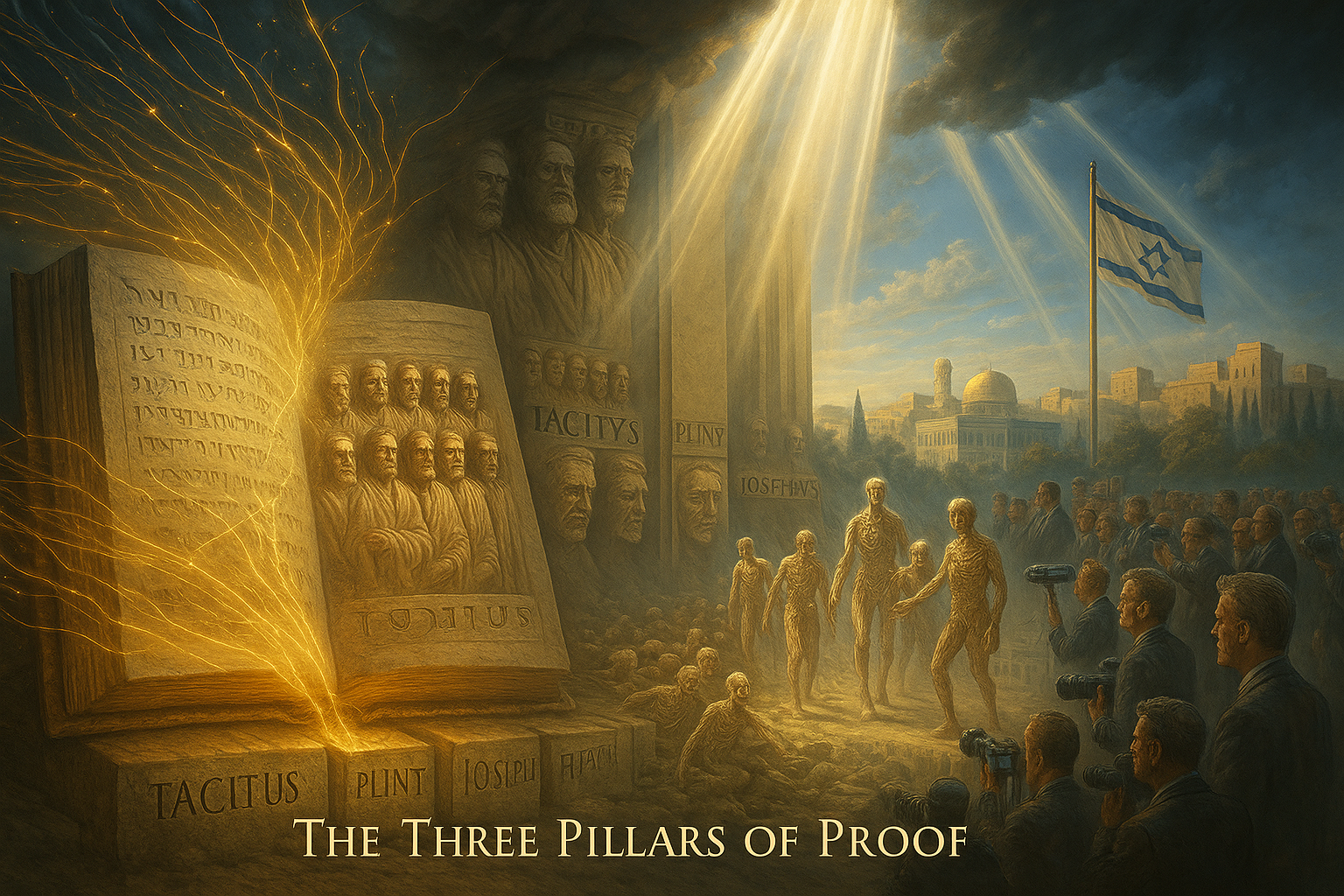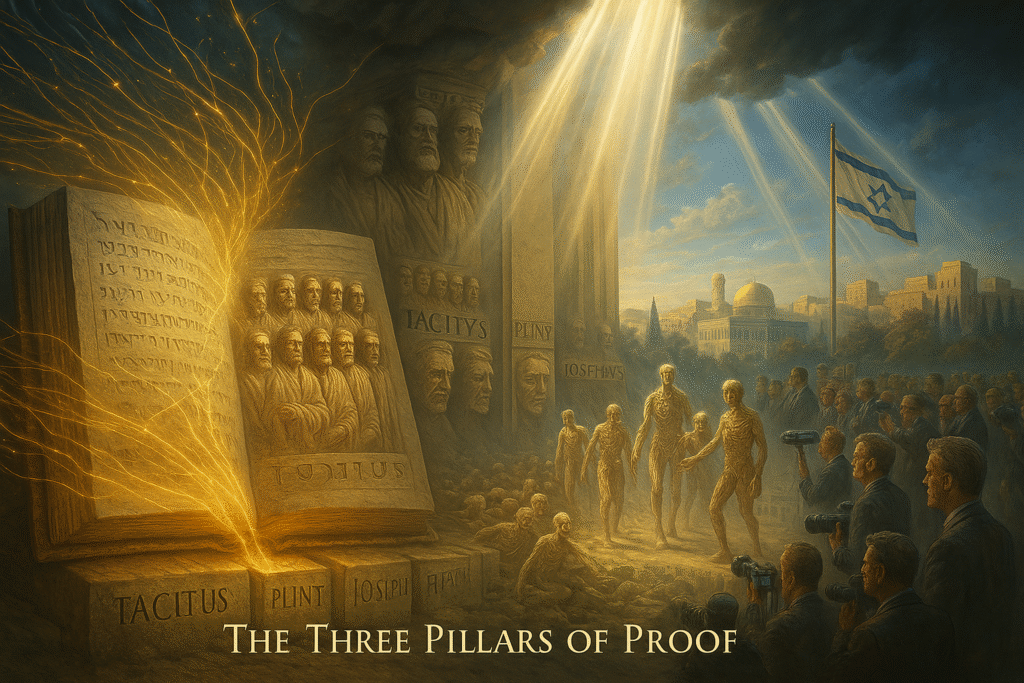Physical Address
304 North Cardinal St.
Dorchester Center, MA 02124
Physical Address
304 North Cardinal St.
Dorchester Center, MA 02124
With Michael Walker
With Michael Walker

Ask….and you shall receive…

The case that now unfolds is not a nervous plea or a tutorial in debate; it is a proclamation presented with the calm certainty of someone reading a sealed ledger aloud. Picture a hall filled with witnesses while a scribe opens the pages of history, and every line bears the fingerprints of Yahweh. The tone is not wandering persuasion but settled verdict. Three immovable pillars carry the weight: the immense catalog of predictive declarations preserved in The Word and systematized by J. Barton Payne; the near-eyewitness documentary record that places Yehoshua concretely in first-century Palestine and binds his life to named persons and public events; and the modern, globally observed restoration of Israel, a fulfillment seen not in cloistered corners but in newspapers, radio broadcasts, and governmental archives. Together these pillars form a single structure so dense with converging lines that casual objection buckles beneath it. This is not argument so much as demonstration.
The first pillar is the prophetic corpus mapped by Payne. His Encyclopedia of Biblical Prophecy is the largest systematic study ever done, cataloging precisely 1,817 individual predictions in The Word: 1,239 in the Old Testament and 578 in the New. Of these, well over a thousand can be shown to have already been fulfilled in history. That is not hearsay; it is counted, indexed, and analyzed. Among these, more than 300 prophecies are identified as directly Messianic, converging on Yehoshua. Consider Micah 5:2 (NASB): “But as for you, Bethlehem Ephrathah, too little to be among the clans of Judah, from you One will come forth for Me to be ruler in Israel.” Yehoshua was born in Bethlehem as recorded in Matthew 2:1. Isaiah 53:5-6 (NASB) declares, “But He was pierced through for our transgressions, He was crushed for our iniquities… the Lord has caused the wrongdoing of us all to fall on Him.” Psalm 22:16-18 (NASB) describes with chilling accuracy: “They pierced my hands and my feet… They divide my garments among them, and they cast lots for my clothing.” These texts, written centuries before crucifixion was even practiced in Israel, match Yehoshua’s death as reported in John 19:23-24. When prophecies regarding lineage (Genesis 49:10; 2 Samuel 7:12-13), suffering (Isaiah 53), vindication (Psalm 16:10), and role as priest-king (Zechariah 6:13) are placed together, the convergence defies coincidence. Payne’s catalog is not a devotional pamphlet; it is a statistical mountain. Prophecies on prophecies on prophecies — nearly two thousand of them — demonstrate orchestration, not accident.
The second pillar stands on the ground of history, and here names matter. Yehoshua did not walk in a vacuum; he was surrounded by men and women whose names are preserved in the records of The Word. The inner circle included Simon Peter (Cephas), Andrew, James son of Zebedee, John, Philip, Bartholomew (Nathanael), Thomas (Didymus), Matthew (Levi), James son of Alphaeus, Thaddaeus (Lebbaeus/Judas son of James), Simon the Zealot, and Judas Iscariot (later replaced by Matthias, Acts 1:26). These disciples lived with him, traveled with him, ate with him, and saw his works. Acts 1:21-22 (NASB) confirms this: “It is necessary that of the men who have accompanied us all the time that the Lord Yehoshua went in and out among us—beginning with the baptism of John until the day that He was taken up from us—one of these must become a witness with us of His resurrection.” Paul in 1 Corinthians 15:3-8 (NASB) writes, “For I handed down to you as of first importance what I also received, that Christ died for our sins according to the Scriptures, and that He was buried, and that He was raised on the third day… and that He appeared to Cephas, then to the twelve. After that He appeared to more than five hundred brothers and sisters at one time, most of whom remain until now, but some have fallen asleep; then He appeared to James, then to all the apostles; and last of all… He appeared to me also.” This is not vague. It is a list: Peter, the Twelve, over five hundred at once, James, the apostles, Paul himself. The eyewitnesses were not anonymous shadows; they were people with names, places, and legacies.
Beyond these internal witnesses are external historians who never followed Yehoshua yet recorded him. Tacitus (c. 56-120 CE), Rome’s greatest historian, wrote in Annals 15.44 that “Christus, from whom the name [Christian] had its origin, suffered the extreme penalty during the reign of Tiberius at the hands of one of our procurators, Pontius Pilatus.” Josephus (c. 37-100 CE), the Jewish historian, in Antiquities 20.9.1 records the death of “James, the brother of Yehoshua who was called Christ.” Pliny the Younger (c. 61-113 CE) in a letter to Trajan describes early followers of “Christ” who sang hymns to him as to a god. Suetonius (c. 69-122 CE) in Lives of the Caesars mentions disturbances “at the instigation of Chrestus.” Even the satirist Lucian of Samosata (2nd century) mocked followers of “the crucified sophist.” These names matter. These are not later preachers but historians, governors, and satirists whose works survive as part of classical literature. And in modern times, leading non-Believing scholars such as Bart Ehrman, Gerd Lüdemann, and Maurice Casey — none of them advocates of faith — insist that the existence of Yehoshua is beyond serious doubt. Ehrman states plainly, “Virtually every competent scholar of antiquity… agrees that Yehoshua existed.” Thus, both ancient testimony and modern scholarship, even from those hostile to faith, confirm the man and the movement.
The third pillar is Israel itself, and here detail must be unfolded. Moses prophesied in Deuteronomy 30:1-5 (NASB): “So it shall be when all of these things have come upon you, the blessing and the curse… and you return to the Lord your God… then the Lord your God will restore you from captivity, and have compassion on you, and will gather you again from all the peoples where the Lord your God has scattered you… and the Lord your God will bring you into the land which your fathers possessed, and you shall possess it.” Ezekiel 37 expands the vision: a valley of dry bones reassembled into a living army, a people restored to their land. Israel’s history matches this prophecy with unnerving precision. Exiled by Assyria in 722 BCE, exiled again by Babylon in 586 BCE, partially restored under Cyrus in 538 BCE, crushed by Rome in 70 CE with the destruction of the temple, and scattered finally after the Bar Kokhba revolt in 135 CE. For nearly two thousand years the people lived dispersed, persecuted in Europe, oppressed under empires, suffering pogroms, ghettos, and finally the Holocaust. By every natural measure, such a people should have disappeared, assimilated, or eradicated, and lost identity. Yet in the late nineteenth century, the Zionist movement under Theodor Herzl began to gather momentum. The Balfour Declaration of 1917 pledged British support for a homeland. In 1947 the United Nations voted for partition, and on May 14, 1948, David Ben-Gurion declared the rebirth of the State of Israel. This restoration was not partial. It was total. Language was restored as Hebrew became the national tongue through the efforts of Eliezer Ben-Yehuda. Currency was restored with the shekel. Sovereignty was restored with the Knesset. Military defense was restored with the Israel Defense Forces. Jerusalem was recaptured in 1967. Piece by piece, prophecy unfolded before the eyes of the entire world. Millions watched as the nations themselves served as eyewitnesses, watching bones take on flesh.
To grasp the scale, consider this analogy. Imagine if the United States were erased: its land occupied, its people scattered into every continent, its Constitution burned, its English language fading into obscurity, its dollar worthless. Imagine two thousand years passing with no homeland, only persecution. Then suddenly, in one generation, America reappears. English revived, the dollar minted again, Congress convened in Washington D.C., its sovereignty defended by armies, its culture alive once more. Would anyone doubt that such an event was extraordinary beyond natural cause? That is what has occurred with Israel, except it was foretold thousands of years ago in The Word. The restoration of Israel is not only a marvel of history; it is living prophecy, performed in daylight, signed by nations, broadcast by radio, photographed by journalists, witnessed by millions.
Placed together, the three pillars do not merely suggest; they compel. Payne’s catalog gives nearly 1,817 predictive declarations, with over a thousand already fulfilled. The disciples and apostles, named and cited, stand as living witnesses, joined by external historians like Tacitus, Josephus, Pliny, Suetonius, and even modern secular scholars who affirm Yehoshua’s existence. The nation of Israel, exiled multiple times, persecuted for millennia, has been restored with land, language, currency, government, and sovereignty in full view of the world. These are not whispers in dim corners; they are shouts from the stage of history.
The analogy of riverbed, footprint, and flood now takes its sharpest form. Prophecy is the riverbed, carved deep across centuries — Payne’s encyclopedia mapping its channels. Witnesses are the footprints pressed into the clay — the disciples, apostles, and historians whose names remain. The flood is the modern restoration of Israel, a torrent rushing visibly before all eyes. Bed, print, water — all align. Or think of a constellation: prophecy as the ancient star chart, witnesses as the medieval chart, Israel’s restoration as the modern telescope. All three show the same figure traced in light. This is not coincidence; it is design.
The conclusion is plain. History has not whispered; it has shouted. The Word has not speculated; it has predicted and fulfilled. Believers did not conjure Yehoshua; he was witnessed, recorded, and named by friends and foes alike. Israel did not survive by luck; it resurrected as a nation in full alignment with prophecy, with the world itself as eyewitness. Yahweh has inscribed his hand on time. Yehoshua is the fulfillment. Israel is the living sign. The evidence is stacked, the record sealed, the conclusion irrefutable. The hall is silent not because of persuasion, but because the record itself has spoken. God is real, and fulfillment has proved it while the world witnessed it. There is no excuse.